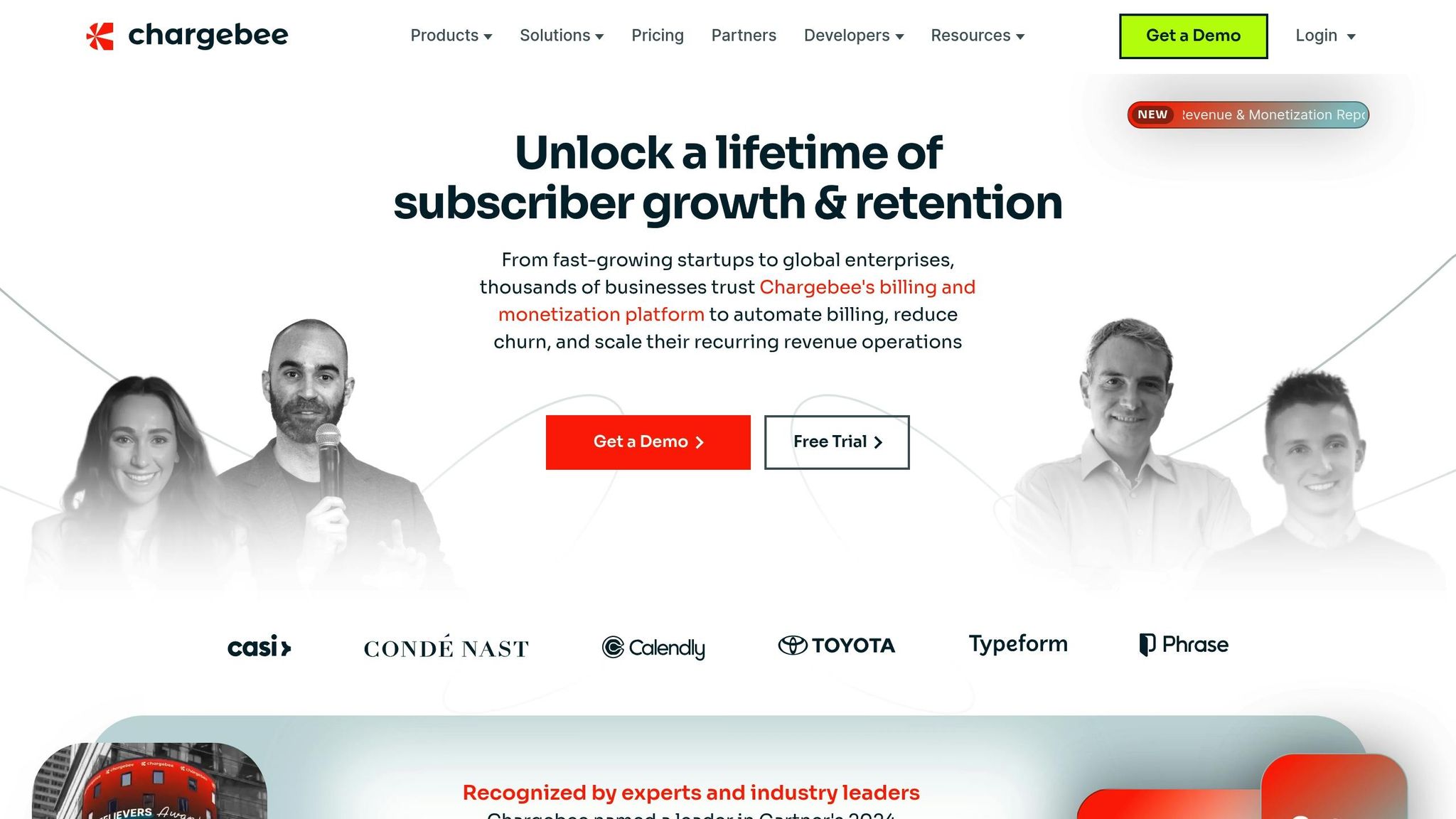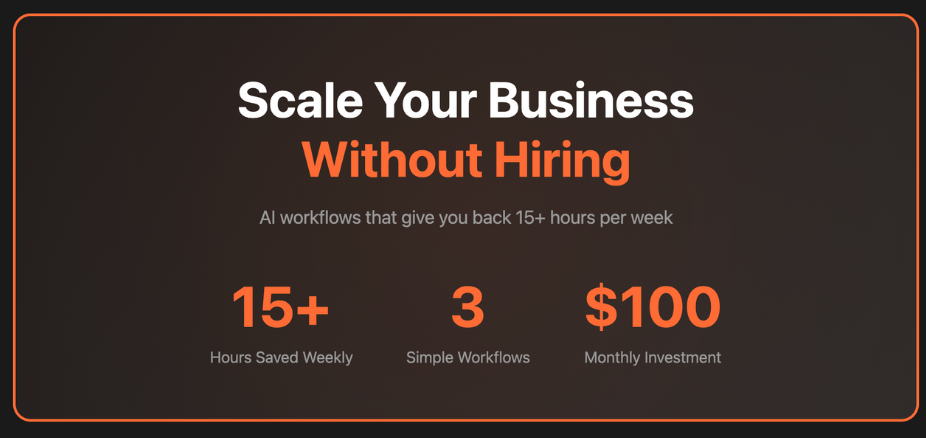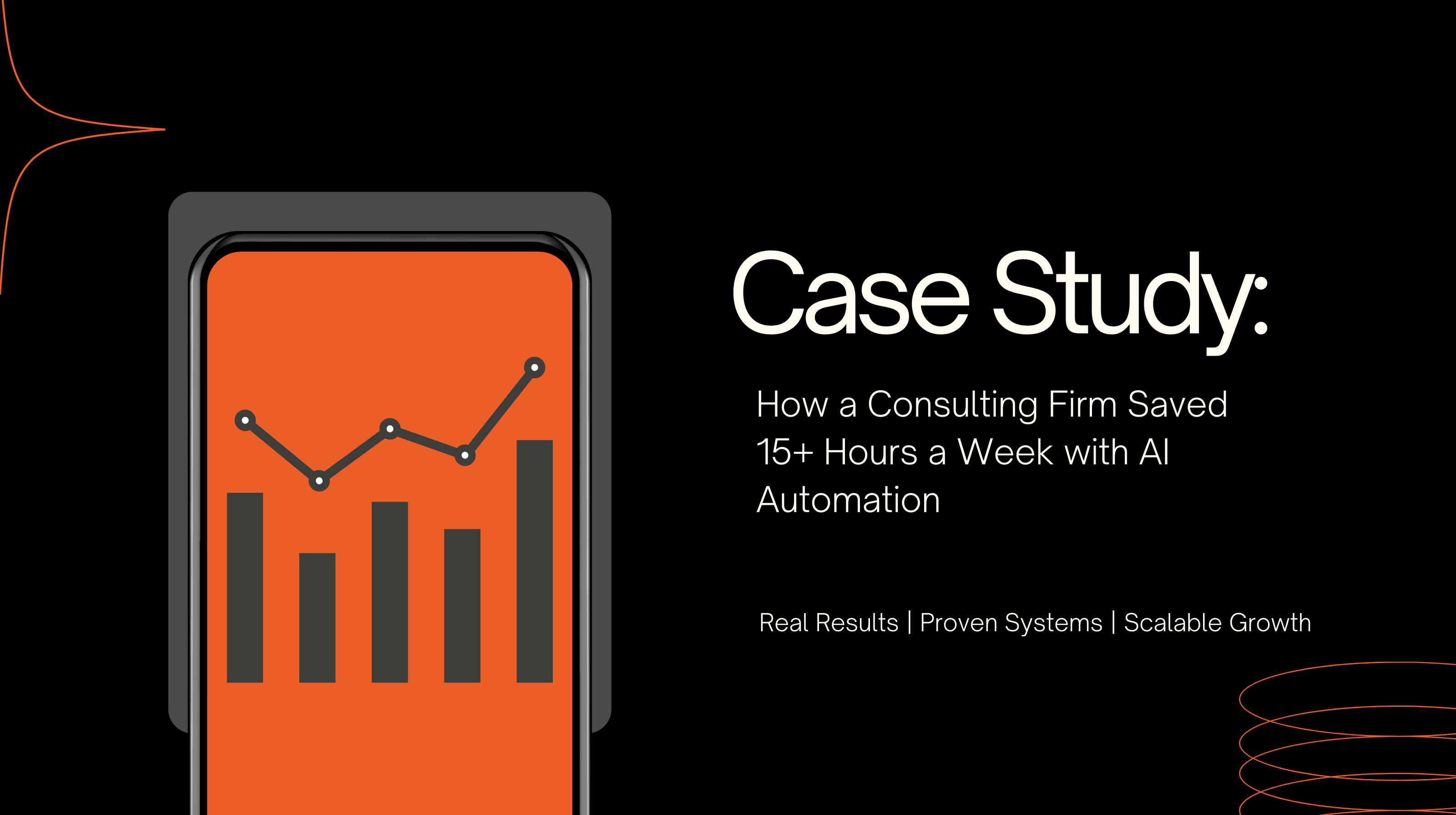CRM automation can transform businesses by saving time, boosting revenue, and improving customer relationships. From SaaS to nonprofits, organizations across industries have achieved measurable results by addressing inefficiencies and automating workflows.
Here’s a quick overview of five success stories:
These examples highlight how CRM systems can address challenges like disorganized workflows, slow response times, and manual tasks. Whether you’re scaling a sales team or improving donor engagement, automation can deliver real results.
How CRM Automation Transformed Investor Outreach | Success Story
Chargebee: Growing Sales Team with CRM Automation

Chargebee, a subscription billing platform, faced challenges as its sales team expanded rapidly. What started as a modest team of three Account Executives ballooned to over twenty, creating operational hurdles that made scaling effectively a tough task.
Challenge: Managing Rapid Sales Team Expansion
Before 2015, Chargebee's sales operations were disorganized and inefficient. The company lacked a proper CRM system, had no clear pricing structure, and operated without a defined sales process. Their primary focus was on acquiring new customers, often at the expense of optimizing revenue.
Sales reps were bogged down by manual tasks like creating proposals and managing follow-ups, which delayed customer interactions. They also struggled to stand out in the competitive subscription billing market due to a lack of unique sales materials, relying mostly on email and web conferences.
By early 2016, it became clear to leadership that their product was undervalued, further complicating their revenue goals.
Solution: Introducing Automation to Simplify Sales Processes
To tackle these issues, Chargebee made bold changes. They hired Germain Brion as VP of Sales and completely revamped their approach to customer relationship management.
The team adopted Freshsales as their main CRM platform, establishing a formalized sales process to track leads, manage customer interactions, and ensure consistent follow-ups. To cut down on time-consuming administrative tasks, they integrated GetAccept into their workflow. This tool allowed sales reps to engage prospects with videos, share trackable sales materials, send proposals, and collect electronic signatures - all within the CRM system.
"We needed a tool to engage prospects with videos, track sales materials, send proposals, and capture signatures - all within our CRM. GetAccept delivered."
These tools brought much-needed efficiency and set the stage for noticeable improvements in sales performance.
Outcome: Boosted Sales Efficiency and Revenue
Within a year of implementing these changes, Chargebee saw remarkable results: the number of deals closed each month increased fivefold, and revenue grew by four times. By automating routine tasks, sales reps were able to spend more time building relationships and closing deals.
The integration between marketing and sales created a smoother customer journey - from the initial interaction to contract signing. This streamlined approach also benefited Chargebee's clients. For example, GetAccept, which utilized Chargebee's automated quote-to-cash workflow, achieved a 4X revenue boost in 2018 by aligning its product features with tailored subscription plans.
Chargebee's transformation highlights how smart CRM automation can help companies scale their teams efficiently while maintaining quality service and driving substantial revenue growth.
B2B Manufacturing: Higher Lead Conversion and Revenue
A global manufacturing company was losing valuable opportunities due to an outdated lead management system. Many inquiries fell through the cracks, never converting into sales.
Challenge: Slow Lead-to-Conversion Process
The company faced several hurdles that slowed their ability to turn leads into paying customers. Their marketing and sales teams operated independently, creating confusion and delays in the customer journey.
Sales representatives struggled with disorganized leads and delayed follow-ups. Studies show that waiting even one hour to follow up on a lead can reduce conversion rates by up to 80%. Unfortunately, the company's manual processes often caused much longer delays.
Additionally, the complexity of their product offerings made it difficult to clearly communicate the benefits to potential customers. In fact, 42% of manufacturing marketers cite demonstrating product value as one of their toughest challenges. This left the sales team struggling to effectively convey the advantages of their solutions.
Another major issue was the fragmentation of data across departments. Siloed datasets led to inaccuracies and inconsistent customer interactions.
"Those who hold customer data and can provide accurate insights into what the market wants are in a powerful position. Data is the 'new oil,' and businesses are seeking more of it all the time." - Cloud 9 Insight
These challenges highlighted the need for a unified, real-time solution.
Solution: CRM Integration with Marketing Automation
To address these issues, the company integrated their CRM system with advanced marketing automation tools. This created a single, real-time view of each customer, giving both sales and marketing teams access to the same data and insights.
By eliminating data silos, the integration streamlined workflows across departments. Sales teams could now act on real-time insights into prospect behavior, while marketers gained the ability to track and adjust campaigns based on accurate data.
The company also implemented clear lead qualification criteria and introduced a lead scoring model to prioritize high-value opportunities. Automated workflows took over repetitive tasks like data entry, lead scoring, and lead assignment, freeing up sales teams to focus on nurturing relationships and closing deals.
Access to unified customer data allowed for more personalized communications, increasing engagement and trust.
Outcome: More Lead Conversions and Revenue Growth
The results were impressive. Within months of adopting the integrated CRM and marketing automation system, the company saw a 28% increase in sales conversion rates and a 35% improvement in lead qualification accuracy. Their sales cycle became 40% shorter.
Streamlined processes, similar to those used by Chargebee, directly boosted efficiency and revenue. Automated lead notifications and task assignments reduced response times by 50%, which significantly improved conversion rates. Sales teams saved 30% of their time on administrative tasks, allowing them to focus more on building customer relationships.
Revenue grew by 25%, while forecast accuracy improved by up to 40% thanks to unified data.
Customer satisfaction also increased by 25%, as prospects received timely and relevant communications throughout their buying journey. The alignment between sales and marketing teams created a seamless experience that resonated with potential customers and sped up their decision-making process.
This case demonstrates how integrating CRM and marketing automation can transform lead management and drive measurable growth.
Dubai Healthcare City: Better Partner and Case Management

Dubai Healthcare City (DHCC) oversees healthcare partnerships and licensing services, but outdated manual processes and disconnected communication tools made it challenging to manage partners effectively.
Challenge: Disconnected Communication and Inefficient Workflows
DHCC encountered three major hurdles that hindered its ability to handle partner relationships and manage cases smoothly
With medical tourism projected to contribute $708 million to Dubai's GDP by 2020 and a forecasted 13% annual revenue growth, DHCC needed a modern, digital solution to keep pace with its expanding responsibilities.
Solution: Implementing a Centralized CRM System
To tackle these challenges, DHCC partnered with SingleClic to roll out Microsoft Dynamics 365 Customer Engagement. This advanced CRM platform was designed to centralize partner data, automate workflows, and enhance visibility into operations.
Key improvements included:
Outcome: Enhanced Operations and Partner Relations
With its new CRM system, DHCC transformed its operations and partner management. Departments now access a unified database, eliminating the need for partners to repeat their information. Automated workflows sped up case handling, reducing delays caused by manual processes. The real-time dashboards gave leadership a clear view of performance metrics, enabling quicker decision-making.
This overhaul has not only improved efficiency but also reinforced DHCC’s ability to support Dubai’s thriving healthcare sector, solidifying its reputation as a global hub for medical excellence.
sbb-itb-d7ea0c6
Book More Brides: Automated Lead Nurturing for Fast Growth

Book More Brides, a company serving the wedding industry, was navigating the challenges of expanding in an intensely competitive market. With numerous vendors vying for the attention of engaged couples, they needed a way to grow efficiently and stand out.
Challenge: Expanding Reach and Managing Leads
The company faced two primary hurdles:
In the wedding industry, where timely and tailored communication is essential, lead nurturing emails can generate response rates 4 to 10 times higher than standard emails. Clearly, automation was the key to overcoming these challenges.
Solution: Personalization Through Automation
To tackle these issues, Book More Brides turned to Ontraport, a CRM platform designed to simplify lead management and improve customer communication. Their approach focused on blending personalization with automation to scale effectively.
The strategy included behavior-based segmentation and automated follow-ups. By analyzing how prospects interacted with their content, the company could sort leads based on their interests and engagement levels. This allowed them to run multi-channel campaigns that retained a personal touch while reaching more people.
The platform’s ability to track customer behavior across various channels meant messages could be adjusted in real time to align with each lead’s preferences. With 56% of marketers citing personalization as a key factor in nurturing success, Book More Brides used this insight to craft automated sequences that felt relevant to each couple’s wedding planning journey.
Outcome: Rapid Growth and Increased Revenue
By implementing CRM automation, Book More Brides transformed their lead nurturing process.
Their email list grew by an astonishing 2,375% through behavior-based automation. This expansion allowed them to connect with a broader audience while maintaining high levels of engagement.
Even more impressive, the company generated nearly $1 million in revenue from just 605 paid community members. This highlights how automated nurturing can turn even a modest subscriber base into a significant revenue stream.
The results didn’t stop there - nurtured leads were shown to spend 47% more than those who weren’t nurtured. By using systematic follow-ups and personalized messaging, Book More Brides maximized the value of each customer relationship while reducing the need for manual effort.
This case demonstrates how CRM automation can help service-based businesses thrive in competitive markets by delivering personalized experiences at scale and driving substantial growth.
Nonprofit Organization: More Donor Engagement and Recurring Contributions
A mid-sized nonprofit was grappling with a tough reality: maintaining meaningful connections with supporters was becoming harder as charitable giving declined. In fact, after adjusting for inflation, charitable donations dropped by 10.5% in 2022. With competition among nonprofits heating up, the organization needed a smarter way to retain donors and keep them engaged.
Challenge: Low Donor Retention and Engagement
The nonprofit faced a series of challenges that were holding back its fundraising efforts and threatening its sustainability.
High donor attrition was a major issue. A staggering 80% of first-time donors never returned to give again. This revolving door of supporters meant the organization had to constantly find new donors instead of nurturing long-term relationships.
Impersonal communication was another problem. The thank-you notes they sent out were stiff and generic, failing to resonate with donors. Penelope Burk, author of Donor-Centered Fundraising, explains the importance of heartfelt acknowledgment:
"Donors feel nothing when they receive poorly timed, stiff, and impersonal acknowledgements for the gifts they make; but their hearts soar and their wallets open upon reading prompt, thoughtful, and original thank-you notes that express the sincere gratitude of the writer."
On top of that, limited resources and outdated processes were slowing them down. They relied on spreadsheets to manage donor information, which made it nearly impossible to analyze data or automate outreach. Without proper tools, personalizing communications was a challenge.
These issues highlighted the need for a more efficient and personalized approach to donor management.
Solution: CRM for Personal Outreach and Tracking
To tackle these challenges, the nonprofit adopted a CRM system designed specifically for nonprofits. This tool streamlined operations and made it easier to connect with donors on a personal level.
The CRM brought all donor information - like giving history, preferences, and engagement levels - into one central hub. This allowed the team to tailor their outreach based on individual donor profiles. They even used custom fields to track unique details, such as donors’ favorite programs and whether they were eligible for matching gifts.
Automated workflows handled tasks like sending prompt thank-you messages, scheduling pledge reminders, and segmenting donors into groups (e.g., first-time donors, monthly givers, and lapsed donors). By factoring in donors’ preferred communication methods and motivations, the nonprofit created campaigns that felt more relevant and personal. The CRM also flagged when follow-ups were overdue or gifts hadn’t been acknowledged, ensuring no donor was overlooked.
Outcome: Better Donor Relationships and Revenue
The results of implementing the CRM system were significant and measurable.
Donor retention saw a marked improvement. Nonprofits that use CRM tools to guide their decisions often experience retention rates of 50–60%. This was a big win, especially considering donor retention had fallen by 2.6% across the sector.
Recurring donations became a reliable source of income. Monthly donors contributed an average of $24 per month (or $288 annually), far surpassing the average one-time gift of $115.
The nonprofit also saw a boost in efficiency. With routine tasks automated, staff could focus on advancing the organization’s mission and deepening relationships with donors.
This transformation underscores how nonprofits, even with limited resources, can use CRM technology to strengthen donor relationships, improve fundraising outcomes, and thrive in a competitive landscape.
Comparison of Success Stories
Examining these five CRM automation success stories side by side highlights just how transformative a well-executed system can be, regardless of industry or business model. Each company faced distinct challenges, yet all achieved measurable results that directly impacted their growth and efficiency. To provide a clearer picture, the table below summarizes the key takeaways from these case studies, capturing recurring themes of streamlined processes, increased productivity, and business growth.
Across the board, CRM systems proved to be a game-changer for revenue and conversion rates. For instance, both the B2B manufacturing company and Book More Brides reported significant revenue increases, while the nonprofit organization saw a marked improvement in donor retention and recurring donations.
The complexity of implementation varied by organization. Chargebee and the nonprofit opted for relatively simple automation setups, while Dubai Healthcare City required a more intricate integration process. Despite these differences, the results were equally impactful.
One standout finding: responding to leads within an hour boosted conversions by an impressive sevenfold, while automated follow-ups added another 10% increase to conversion rates. Chargebee's case further illustrated this, with tailored CRM workflows improving sales productivity by as much as 45%.
Certain industry-specific benefits also emerged. For example, Dubai Healthcare City saw significant improvements in partner communication and case management. Meanwhile, Book More Brides thrived by implementing personalized nurturing campaigns. For nonprofits, access to detailed donor data - a benefit cited by 74% of businesses as critical for CRM success - enabled better understanding of donor behavior and preferences.
What ties all these stories together is the way CRM automation freed up resources for higher-impact activities. By cutting down on manual tasks, organizations achieved an average return of $8.71 for every dollar spent on CRM systems. These results underline the broad and meaningful advantages of CRM automation across different sectors.
Conclusion
These five CRM automation success stories demonstrate how strategic use of automation can lead to measurable growth across industries and businesses of all sizes. From Chargebee boosting sales team efficiency to a nonprofit improving donor retention, each example highlights how well-planned automation can enhance operations and drive revenue.
For instance, companies utilizing real-time analytics have reported a 30% increase in conversion rates, thanks to faster responses to leads. Similarly, integrating a customized CRM system can result in up to a 45% boost in sales productivity. These figures align with broader industry trends, where effective data use contributes to a 15% improvement in campaign performance that directly impacts sales.
Automation solves common business hurdles like poor data quality, communication breakdowns, and resource-heavy manual tasks. These case studies illustrate how CRM automation simplifies repetitive tasks, reduces errors, and allows teams to focus on strategic priorities.
"CRM implementation is important because it helps businesses improve customer satisfaction, streamline internal processes, make data-driven decisions, and foster collaboration across departments."
The key takeaway here is that successful CRM automation goes beyond just installing software. It requires strategic planning, high-quality data, and ongoing optimization.
For businesses ready to tap into these advantages, Devcore offers custom AI and automation solutions through their proprietary Leverage Blueprint™. Their expertise includes automating repetitive tasks, building AI-powered decision-making tools, and creating seamless system integrations - all aimed at delivering tangible business results.
On average, companies adopting AI-driven CRM systems experience a 20–30% increase in sales revenue and a 15–25% reduction in customer churn. Additionally, investing in automation can yield an ROI of up to 400%, thanks to reduced labor costs and improved productivity. The real challenge is taking that first step - so why wait?
FAQs
How can CRM automation help nonprofits retain donors and boost engagement?
CRM automation plays a key role in helping nonprofits strengthen donor relationships by taking care of tedious tasks like sending personalized thank-you emails, scheduling follow-ups, and maintaining regular communication. These small but vital actions ensure donors feel appreciated and stay connected to the organization.
Today's CRM systems go a step further by offering a detailed view of donor interactions and preferences. With this information, nonprofits can personalize their outreach efforts, fostering deeper connections with donors. This tailored approach not only boosts donor loyalty but also encourages sustained support for the organization's mission over time.
What should a manufacturing company look for in a CRM to boost lead conversion rates?
When choosing a CRM system to boost lead conversion rates, manufacturing companies need to prioritize tools that simplify sales and marketing workflows, offer in-depth tracking of metrics like conversion rates, and improve customer engagement. A good CRM should also integrate features for order and inventory management, ensuring smooth operations and a better overall customer experience.
It's important that the CRM can be tailored to fit your specific business requirements. Look for solutions that provide operational, analytical, and collaborative tools. This way, you can manage leads effectively while nurturing customer relationships, setting the stage for measurable growth in your business.
How can CRM automation help service-based industries, like wedding services, grow their revenue?
CRM automation plays a crucial role in helping service-based industries, like wedding services, boost revenue by simplifying operations, managing leads more effectively, and strengthening customer relationships. By taking over repetitive tasks - such as scheduling appointments, sending follow-up messages, and running marketing campaigns - businesses free up valuable time to focus on delivering outstanding service.
Take wedding venues as an example. With CRM automation, they can handle bookings and manage leads with ease, leading to higher conversion rates and smoother customer experiences. Plus, automation allows businesses to tailor their communication with clients, building trust and increasing the chances of repeat bookings or word-of-mouth referrals. These operational improvements and stronger client connections naturally translate into higher revenue and steady business growth.
Related posts
- Manual Workflows Slowing Growth? AI Solutions
- How to Measure Automation ROI: 6 Key Metrics
- How Computer Vision Improves Quality Control Processes
- Using AI to Prevent Customer Churn
{"@context":"https://schema.org","@type":"FAQPage","mainEntity":[{"@type":"Question","name":"How can CRM automation help nonprofits retain donors and boost engagement?","acceptedAnswer":{"@type":"Answer","text":"<p>CRM automation plays a key role in helping nonprofits strengthen donor relationships by taking care of tedious tasks like sending personalized thank-you emails, scheduling follow-ups, and maintaining regular communication. These small but vital actions ensure donors feel appreciated and stay connected to the organization.</p> <p>Today's CRM systems go a step further by offering a <strong>detailed view of donor interactions and preferences</strong>. With this information, nonprofits can personalize their outreach efforts, fostering deeper connections with donors. This tailored approach not only boosts donor loyalty but also encourages sustained support for the organization's mission over time.</p>"}},{"@type":"Question","name":"What should a manufacturing company look for in a CRM to boost lead conversion rates?","acceptedAnswer":{"@type":"Answer","text":"<p>When choosing a CRM system to boost lead conversion rates, manufacturing companies need to prioritize tools that simplify <strong>sales and marketing workflows</strong>, offer in-depth tracking of metrics like conversion rates, and improve customer engagement. A good CRM should also integrate features for <strong>order and inventory management</strong>, ensuring smooth operations and a better overall customer experience.</p> <p>It's important that the CRM can be tailored to fit your specific business requirements. Look for solutions that provide operational, analytical, and collaborative tools. This way, you can manage leads effectively while nurturing customer relationships, setting the stage for measurable growth in your business.</p>"}},{"@type":"Question","name":"How can CRM automation help service-based industries, like wedding services, grow their revenue?","acceptedAnswer":{"@type":"Answer","text":"<p>CRM automation plays a crucial role in helping service-based industries, like wedding services, boost revenue by <strong>simplifying operations</strong>, <strong>managing leads more effectively</strong>, and <strong>strengthening customer relationships</strong>. By taking over repetitive tasks - such as scheduling appointments, sending follow-up messages, and running marketing campaigns - businesses free up valuable time to focus on delivering outstanding service.</p> <p>Take wedding venues as an example. With CRM automation, they can handle bookings and manage leads with ease, leading to higher conversion rates and smoother customer experiences. Plus, automation allows businesses to tailor their communication with clients, building trust and increasing the chances of repeat bookings or word-of-mouth referrals. These operational improvements and stronger client connections naturally translate into higher revenue and steady business growth.</p>"}}]}




